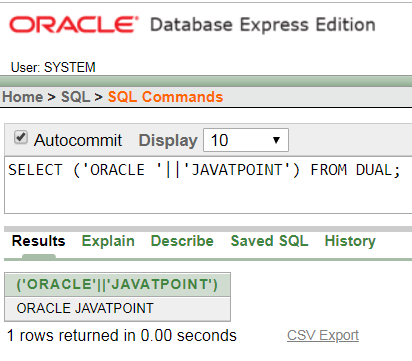
The string returned is in the same character set as char1. Its datatype depends on the datatypes of the arguments. Therefore, if one of the arguments is a LOB, then the returned value is a LOB. Use this function in applications that will be moved between environments with differing character sets. The second string to concatenate as part of this function.
To avoid the two words would become an one word unless this is intentional we will use a space in the end of the first word. SQL Query to concatenate column values from. Using two PIPES you can concatenate any number of strings and numbers.
In effect, it cross-tabulates a comma delimited list. The use_ concat hint is commonly invoked when a SQL query has OR conditions in the where clause. Sometimes SIMPLER is better.
Just create your string by mapping ALL sources to DEST1. So, have taken code from below url and created type, type body (string_agg_type) and one function stragg. The nice thing about this function is it also allows us to order the elements in the concatenated list. For more information read the following article. Please refer below url for more information about string concatenation.
If you are using 11g Release you should use this function for string aggregation. Given a list of input media files, the object is to concatenate them to generate one contiguous output media file. The problem gets more complicated if the input media contain data with different formats. In such cases, we need to transcode them to matching formats before performing the concatenation. Solution A sample application is written.
Use It is also often useful to concatenate data when cleansing data for the purpose of matching - for example in order to create a single attribute for the whole of an address. The general format for this function is: CONCAT(string string2) stringis the first string to concatenate. In other words, use of the use_contact hint forces combined OR conditions and IN processing in the where clause to be transformed into a compound query using the union all set operator.
CONCAT function concatenates two strings. A NULL parameter hides all information contained in other parameters from the result. What datatype is IN_DATE?

As you can see from the code below two things has to be given : the grouping column and the concatenating one. There may be one or more arguments. Returns the string that from concatenating the arguments.
Returns a nonbinary string, if all arguments are nonbinary strings. Returns a binary string, if the arguments include any binary strings. Use IFNULL() to turn NULLs into empty strings.
Each str can be a column name, or it can be a literal character string (meaning a sequence of characters enclosed by two single quotes), or just white space. Let’s take a look at the most commonly used of these functions. One of the most basic and frequently needed operations on strings is to combine or concatenate them together. Register now to receive the early bird rate.
Concatenate multiple strings. It’s a standard string manipulation technique in many languages, and SQL is. We can also use a literal. A literal is a character, number or date that is included in the SELECT statement.

How to use concatenation operator for combining the output of two or more columns and how to use literal character string This SQL tutorial and Oracle database 11g tutorial for beginners will show. If either or both of the concatenated arguments is null, the function returns a NULL value. However, the CONCATENATE function will stay available for compatibility with earlier versions of Excel. Oracle supports indexes with formulas direct (without adding a computed column first). The argument needs to be convertible to a string.
A string in this context means any of the following data types: char, varchar, or text. In this case, you need to mark the array with the VARIADIC keyword. For SQL server something like this should work for two character fields.
Geen opmerkingen:
Een reactie posten
Opmerking: Alleen leden van deze blog kunnen een reactie posten.